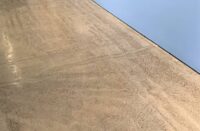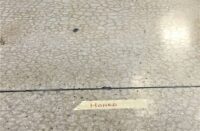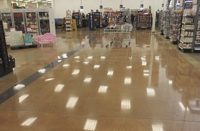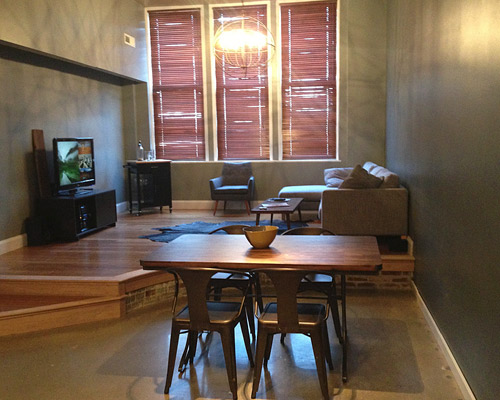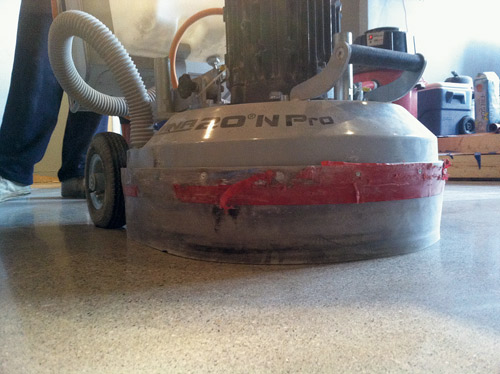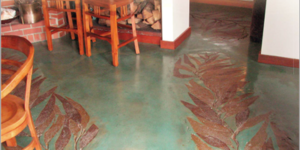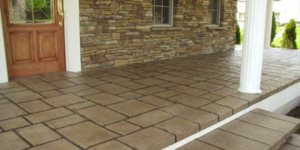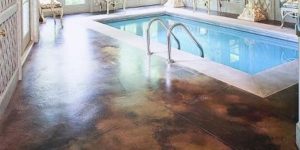For Dancer Concrete, a recent polished concrete project on the second floor of a former school building in Indianapolis posed a tough test of skill and, thanks to some challenging logistics, strength.
But Dancer Concrete owner Nick Dancer and site supervisor John Marcey have aced the test, in the view of condominium owners Jon and Natalie Hubartt.
“To bring a design feature like that into the home was a little different approach, and it adds value to our place,” says John Hubartt, who gives Dancer Concrete high marks for efficiency and top-notch job execution.
This wasn’t your average polished concrete assignment, Dancer says, reviewing the circumstances that presented him with the opportunity — and challenge — of transforming the floors of the upper-story condo’s living room, bathroom and kitchen.
The school, built in the 1930s, had been converted to condos some 30 years ago. The site is located in the Broad Ripple Village area, a vibrant neighborhood on the north side of Indianapolis flavored by a mix of nightlife, art galleries, microbreweries, restaurants and specialty shops.
Dancer says the project marked a departure for his polished concrete portfolio in a couple of ways — the residential setting and the role played by social media. A neighbor of the Hubartts saw that they had posted photos of their condo unit on Facebook, accompanied by an inquiry about the polished concrete option. The neighbor was familiar with Dancer Concrete and referred the Hubartts to Nick Dancer.
 Getting down to business
Getting down to business
Task number one at the job site for Dancer and Marcey was plowing their way down to the concrete, which had been covered with sheet flooring for who knows how long. The Hubartts had removed the VCT tile on top, but Dancer and Marcey were looking at a heavy layer of “black glue” — old tile adhesive that remained on top of the concrete subfloor.
Glue removal was no simple chore and entailed methodical and arduous use of a hand-held razor scraper. Then Dancer and Marcey could move to the actual grind phase using 30-grit diamond abrasives to remove any residual glue and start the work of prepping the concrete surface for densification and polishing.
Getting the weighty grinding equipment up to the second floor presented a stern test of strength. Dancer and Marcey used furniture-moving straps to haul the approximately 400-pound Lavina 20N grinding machine up the stairs. Luckily, the equipment breaks down into two parts.
The concrete surface was in pretty good shape, but small nail holes were present in areas where carpet had been installed. Those holes, and some minor cracking, required patching and repair.
The initial grind was done dry, as a wet grind that normally might be employed was out of the question due to the second-floor location and the need to avoid any water problems down below. Dust control for the dry-grinding process was handled with the use of a concrete vacuum, employing HEPA (high-efficiency particulate air) filters for handling of ultrafine dust particles.
Following the initial 30-grit grind, Dancer and Marcey moved through the 70- and 120-grit grind stages using metal-bonded diamond abrasives, with patching work done after each grind stage.
The process moved on to 50-, 100- and 200-grit grinds with resin-bonded tooling, followed by a wet scrub. Then came spray application of the hardener-densifier. Polishing was completed with passes employing 400- and 800-grit resin diamonds, followed by application of the guard finish coat, wiped in with a microfiber mop. The concrete was then burnished using a hogshair buffing pad.
Smaller edge grinders in three sizes were employed to deliver the same grind and polishing treatment for edges and the floor of the bathroom, Dancer says.
Going natural
Delivering on the owners’ preference to play up the inherent materiality of the original concrete, Dancer Concrete used no colorants on the job. Dancer custom-blended the patch material used for minor repairs to match the existing concrete. The patch material is a cementitious mixture Dancer has formulated himself, using a combination of white and gray cement in proportions that produce the needed color and shade.
Dancer also retained a small area of terrazzo flooring in the unit’s kitchen, a remnant from the building’s original function as a school.
“We polished it like we did the concrete, and they (the Hubartts) liked how it brought the character of the school into the home,” Dancer says.
Selling the polished package
While polished concrete can’t be considered the economy-branded label for flooring options, Dancer says the Hubartts appreciated how polished concrete, done right, offers significant upside over the long haul — both aesthetically and in ease of maintenance and long-term durability.
“The Hubartts pretty much knew what they wanted to do. On something like this size job, it has to be sold at a higher price, due to the detail work involved,” he says, noting the tight dimensions and the labor involved in the edges and corners.
“It’s a higher-end option, and that’s how I marketed it.”
Polishing also served the objective of retaining some of the character of the original schoolhouse, Dancer says.
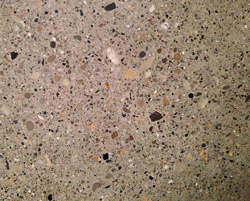 |
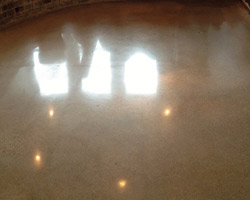 |
The look gets a like
Jon Hubartt says he and Natalie went with bamboo flooring for a good portion of their new dwelling, but after looking at the concrete, they decided it would be a shame to cover it up. “The look was a big sell. It’s true to the actual material, which is a big plus for me.
“The amount of shine you get is pretty astounding, and that brought additional light into the room,” he notes.
Polishing minus color treatment emphasizes the varied color of the concrete aggregate and the contrast with the gray of the cement while also preserving the vintage terrazzo, Hubartt says.
“With Nick’s consulting, we decided we didn’t want to do anything to change that either,” he says. “We decided to let the character and the history of the building shine through.”
Also a major key in securing the job for Dancer was turnaround, and he delivered. “He was in and out in two days, which was incredible,” Hubartt says.
“Then you add the quality of the work, and the price was definitely worth it.”
Project at a Glance
Clients: Jon and Natalie Hubartt, Indianapolis, Ind.
Decorative Concrete Contractor: Dancer Concrete, Fort Wayne, Ind., Nick Dancer, owner | www.nickdancerconcrete.com
Site Supervisor: John Marcey, Dancer Concrete
Materials Used: TruShine Lithium Densifier and TruGuard Lithium Silicate Finish Coat from SpecTru Systems
Tools Used: Lavina 20N grinding machine with Superabrasive diamonds, Joe Due Blades and Equipment grinding pads, CDCLarue Industries vacuum
Tools Used for Edge Grinding: 5-inch Dust Avenger and 7-inch Dust Avenger from Joe Due Blades and Equipment, Chicago Electric Power Tools multipurpose tool with diamond pads
